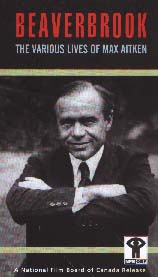| ________________ CM . . . .
Volume VIII Number 1 . . . . September 7, 2001
excerpt: "Somebody once asked him if "Max" was short for Maximillian. He said it was short for Maximultimillion.Multimillionaire, press baron and entrepreneur extraordinaire, Max Aiken was, in his time, the most powerful Canadian on the world stage. He is the stuff of legend. The Canadian-born son of a Presbyterian minister, Aitken didn't start off as a tycoon. At age 20, he was flat broke, running a bowling alley in Canada. By age 32, he was living the high life in London as a multimillionaire, a knight and a member of Britain's parliament. Aitken eventually climbed to the heights of the British aristocracy, taking the title Lord Beaverbrook, befriending Winston Churchill and building the world's greatest newspaper empire. Not bad for a kid from New Castle, New Brunswick." This splendidly produced NFB video demonstrates that cliches can, in fact, reflect reality at times: "One of a kind" and "Larger than life" seem strangely appropriate in this warts-and-all portrayal of a genuinely unique Canadian. Except perhaps within the turn-of-the-century "rags to riches" fraternity to which he did not actually belong, at the "rag" end at least, Beaverbrook's life story (1879-1964) is really representative of no one but himself. Nonetheless, his odyssey is a fascinating tale in itself; and, as presented in this video narrated by Patrick Watson, the portrayal is fair and balanced, but it is most certainly not iconography. The same qualities that made Beaverbrook a giant on the world stage made him at times less admirable in other dimensions of his life. Though many found him a "lovable scoundrel" and an eccentric who often seemed more like a movie character than a real person, the video does not make light of his chronic infidelity to his wife, his insensitive treatment of his children, and his tendency toward callous bullying of employees and business associates. An unvarnished examination is also made of the business and financial scandals that almost brought him to court in Canada and which occasioned his very rapid move to Britain. At the same time, yet another side of this complex man is shown in his abiding loyalty to his home province. Annual return visits to New Brunswick and enormous contributions to its cultural and educational institutions seem in strange contrast to the cynical miser portrayed in other settings. Because Beaverbrook occupied so central a stage, his story allows glimpses into the life of the privileged during the first half of the century and of power of money to buy political protection and to move to the highest levels of the social establishment. At the same time, due respect is accorded his business and political achievements both of which were of major significance. On the one hand was the building of the largest and most newspaper holding in the world at a time when newspapers were the primary source of opinion making and during which the "press barons," so-called, were not at all hesitant to use their papers to spread a particular world-view or as in Beaverbrook's case savage one's enemies. And on the other hand was a legendary stint of public service, as the first British Minister of Information, and later the Minister of Aircraft Production and thereby a major player in the narrowly won and critically important World War II Battle of Britain. The NFB video makes excellent use of black-and-white historical film footage and intersperses that with beautiful colour photography of the settings involved in the story, in Canada and in Britain. Very effective use is made as well of commentary from people who knew him well: his biographers, his family, his business and political associates. These individual pieces add a balance, subtlety and human dimension that simple narrative alone cannot. Anyone interested in this period of Canadian and British history or anyone interested in a thoroughly fascinating personal story intertwined through the major events and forces of those times will enjoy the video. As a teaching device, it will be valuable in emphasizing the human dimension of people and events that in the presentation of our history are too often portrayed in a disembodied fashion. Highly Recommended. Alexander D. Gregor is Associate Dean (Graduate Programs) in the Faculty of Education, University of Manitoba.
To comment on this
title or this review, send mail to cm@umanitoba.ca.
Copyright © the Manitoba Library Association. Reproduction for personal
use is permitted only if this copyright notice is maintained. Any other
reproduction is prohibited without permission.
Published by TABLE OF CONTENTS
FOR THIS ISSUE - September, 2001.
AUTHORS | TITLES | MEDIA REVIEWS | PROFILES | BACK ISSUES | SEARCH | CMARCHIVE | HOME |
